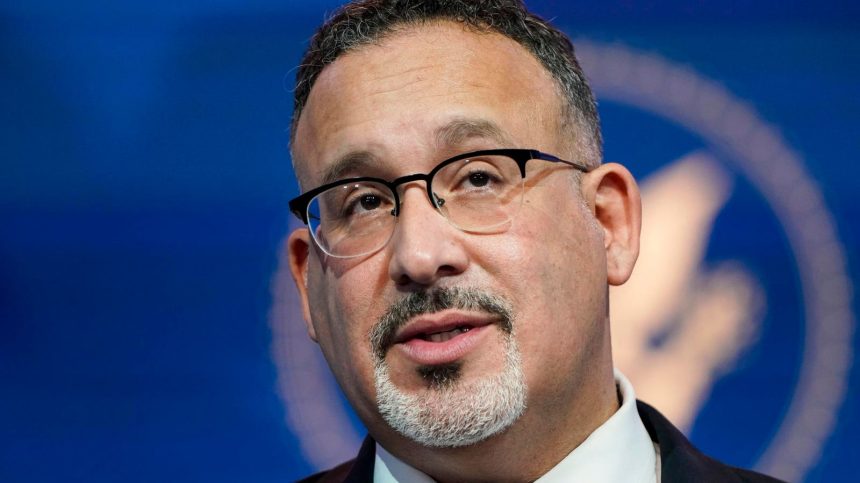The Biden administration sent out emails on Friday to millions of borrowers, notifying them of an upcoming mass student loan forgiveness plan that has been in the works for more than a year. The email will provide details on the new program, and will give borrowers an opportunity to opt out before it’s launched this fall.
“STOP SCROLLING,” said U.S. Secretary of Education Miguel Cardona in a statement on X on Friday. “I’m sending 40 million borrowers info on student debt relief this morning.” He encouraged borrowers to “read the email to get more information about potential relief!”
The latest loan forgiveness initiative, which Biden officials are touting as a replacement plan for the one that the Supreme Court rejected last summer, will focus on four groups of borrowers, many of whom may qualify for automatic relief without submitting an application. Here’s what borrowers need to know.
Who Would Qualify For Student Loan Forgiveness Under New Biden Plan
The Biden administration has been working on a new student loan forgiveness plan since June 2023, when the Supreme Court ruled that Biden’s first attempt at mass debt cancellation was illegal and exceeded what Congress had authorized. For that plan, the administration had relied on the HEROES Act, a 20-year old statute that authorizes waivers of federal student loan repayment requirements in response to national emergencies.
This time, the Biden administration is relying on a “compromise and settlement” provision of the Higher Education Act, which has been routinely used by Democratic and Republican administrations to settle or eliminate federal student loan debt, albeit on a significantly smaller scale than what officials are now trying to do.
The proposed plan will target student loan forgiveness for four groups of borrowers. This includes those who have experienced significant interest accrual or capitalization (leading to runaway balance growth); borrowers who attended low-value schools with poor student outcomes; those who qualify for existing loan forgiveness plans but haven’t applied; and borrowers who first entered repayment more than two decades ago. A fifth group of borrowers could qualify for loan forgiveness based on hardship, but that pathway will likely be rolled out separately at a later date.
The Education Department “is in the process of finalizing who will be eligible for student debt relief” under the program, says official guidance. This suggests that administration officials could still tweak certain eligibility criteria in the coming weeks.
What’s In The Student Loan Forgiveness Notice Going Out To 40 Million Borrowers
The notices that the Education Department is sending out today will provide an overview of the new student loan forgiveness plan, as well as an opportunity to opt out.
If you receive an email from the U.S. Department of Education, “don’t delete it,” says a video message that Secretary Cardona shared on X on Friday.
“The email came from Secretary Cardona, and the subject line said ‘Upcoming student debt relief from the Biden-Harris administration,’” continues the video. “If you don’t immediately see it, make sure to check your spam and your junk folders just in case.” The notices will include an overview of the categories of borrowers who could qualify for loan forgiveness under the initiative.
Borrowers don’t need to do anything right now to qualify for relief, but as a first step, they must decide if they want to opt out.
“The first step is simple,” says the department’s video message. “Read the email. If you’re interested in relief, you don’t have to do anything. If you aren’t interested in relief, call your servicer to let them know that you don’t want it.” The deadline for doing so is August 30, according to the department. But opting out could also result in the borrower “temporarily” opting out of student loan forgiveness under IDR plans.
While not explicitly stated in the department’s video message, the “opt-out” notice is likely being provided to borrowers in anticipation of automatic student loan forgiveness. The Education Department has sufficient data to identify many of the borrowers who would qualify for relief under the first four categories without requiring them to submit a formal application. By not opting out during the 30-day opt-out window, borrowers are effectively consenting to receiving automatic relief once the program goes live.
Student Loan Forgiveness Could Happen This Fall
It is becoming increasingly clear that the Biden administration plans on implementing the new student loan forgiveness plan soon, likely this fall.
“As part of the Biden-Harris Administration’s student debt relief efforts, this fall, the U.S. Department of Education (ED) aims to provide debt relief to certain borrowers,” says updated department guidance.
The fall target implementation is also likely why the Education Department is sending out email notices now, with an opt-out deadline of August 30. The first day of fall is September 22, so this would give the department sufficient time to process opt-out requests before relief can begin, presumably either in late September or sometime in October.
Nearly 5 Million Borrowers Have Already Received Loan Forgiveness Under Other Programs
Meanwhile, despite last year’s Supreme Court ruling, the Biden administration has managed to implement nearly $170 billion in student loan forgiveness for close to five million borrowers through other initiatives. These include improvements to the Public Service Loan Forgiveness program, a retroactive fix for Income-Driven Repayment plans, group discharges for borrowers harmed or defrauded by their schools, and updated regulations for borrowers facing severe medical impairments.
Several of the Biden administration’s student debt relief initiatives are facing legal challenges, however. Last month, a federal appeals court blocked the SAVE plan, a new income-driven repayment option that can lower payments and speed up loan forgiveness for certain borrowers. The ruling has thrust much of the federal student loan system into chaos. Many observers expect Biden’s newest student loan forgiveness program to get challenged in court, as well.
Read the full article here
















